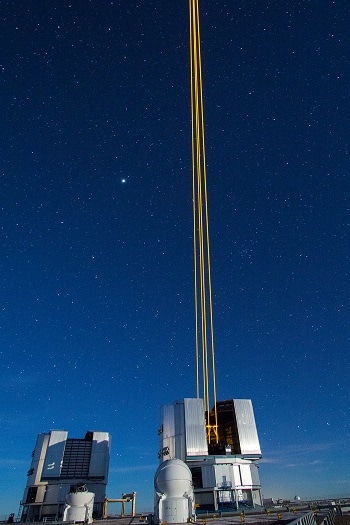On April 26th, the impressive Four-Laser Guide Star Facility (4LGSF) was fully operational for the first time at the European Southern Observatory’s (ESO) Very Large Telescope (VLT) of the Paranal Observatory in Chile. During the preceding verification phase, a team of TOPTICA and ESO engineers successfully completed the required system tests. This is a major step towards the completion of the Adaptive Optics Facility (AOF) and evident proof of the capability of TOPTICA’s ground-breaking guide star solution.
 Due to Rayleigh scattering, the SodiumStar laser beams are visible up to a height of a few tens of kilometres. When they enter the sodium layer at about 100 km altitude, they generate an artificial star used for adaptive optics correction.
Due to Rayleigh scattering, the SodiumStar laser beams are visible up to a height of a few tens of kilometres. When they enter the sodium layer at about 100 km altitude, they generate an artificial star used for adaptive optics correction.
In the upgraded AOF at the VLT, four independent TOPTICA lasers are used simultaneously to implement most advanced modes of adaptive optics. The laser light is absorbed and re-emitted by sodium atoms in a layer at the edge of the mesosphere, about 90 – 110 km above earth’s surface. On its way back to the telescope, the re-emitted fluorescence light experiences the same atmospheric distortions as the light coming from real stars. Therefore, the point-like fluorescence light of a laser guide star can be used to measure the atmospheric image blurring effects and compensate them with a deformable mirror in the telescope. Using several lasers, the air volume above the telescope’s main mirror is probed in a process called atmospheric tomography. This enables near-diffraction-limited images of the complete field of view and even better resolution for smaller fields of interest. The new AOF will allow the exploration of extragalactic galaxies and will also be an important milestone for the ongoing implementation of the 40-m European Extremely Large Telescope (E-ELT) on neighboring Cerro Armazones.
The new lasers can be considered the third generation of sodium guide star laser technology, bringing laser schemes from quantum optics to astronomy.With our novel repumping approach we can by far surpass existing sources in their key parameter for this application, the fluorescence photon return flux.
TOPTICA President Wilhelm Kaenders
TOPTICA’s SodiumStar laser is a compact and maintenance-free turnkey system developed in collaboration with the Canadian company MPB Communications Inc. and ESO’s guide star laser group. Each laser delivers 22 W of diffraction-limited, narrowband, continuous-wave radiation at a sodium resonance near 589 nm, including up to 12% of the power at a second repumper frequency. This is achieved by amplifying the output of a wavelength-stabilized quantum dot DFB diode in a narrow-band Raman fiber amplifier and subsequent frequency-doubling by resonant second-harmonic generation with up to 90% efficiency. The superior performance of this laser has been independently confirmed recently at several telescopes and in direct comparison with legacy technology. Detailed results will be published at the SPIE Astronomical Telescopes and Instrumentation conference in Edinburgh in June.